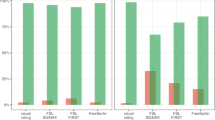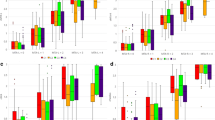Abstract
Objectives
Dementia is foremost a clinical diagnosis. However, in diagnosing dementia, it is advocated to perform at least one neuroimaging study. This has two purposes: to rule out potential reversible dementia (PRD), and to help determine the dementia subtype. Our first goal was to establish if MRI combined with visual rating scales changes the clinical diagnosis. The second goal was to demonstrate if MRI contributes to a geriatrician’s confidence in the diagnosis.
Methods
The dementia subtype was determined prior to and after MRI. Scoring scales used were: global cortical atrophy (GCA), medial temporal atrophy (MTA), and white matter hyperintensity measured according to the Fazekas scale. The confidence level of the geriatrician was determined using a visual analogue scale.
Results
One hundred and thirty-five patients were included. After MRI, the diagnosis changed in 23.7 % (CI 17.0 %-31.1 %) of patients. Change was due to vascular aetiology in 13.3 % of patients. PRD was found in 2.2 % of all patients. The confidence level in the diagnosis increased significantly after MRI (p = 0.001).
Conclusions
MRI, combined with visual rating scales, has a significant impact on dementia subtype diagnosis and on a geriatrician’s confidence in the final diagnosis.
Key points
• MRI with visual rating scales changes the dementia subtype diagnosis significantly.
• MRI is essential in demonstrating vascular disease as a cause of dementia.
• All suspected dementia patients should undergo an MRI with visual rating scales.
• MRI improves a geriatrician’s confidence in the diagnosis of the dementia subtype.
• MRI remains essential during the workup of dementia to exclude reversible causes.
Similar content being viewed by others
Abbreviations
- AD:
-
Alzheimer’s disease
- GCA:
-
global cortical atrophy
- MCI:
-
mild cognitive impairment
- MMSE:
-
mini mental state exam
- MTA:
-
medial temporal atrophy
- PRD:
-
potential reversible dementia
- VAS:
-
visual analogue scale
References
Prince M, Bryce R, Albanese E, Wimo A, Ribeiro W, Ferri CP (2013) The global prevalence of dementia: A systematic review and metaanalysis. Alzheimers Dement 9:63–75
Ferri CP, Prince M, Brayne C et al (2005) Global prevalence of dementia: a Delphi consensus study. Lancet 9503:2112–2117
Larson EB, Edwards JK, O'Meara E, Nochlin D, Sumi SM (1996) Neuropathologic diagnostic outcomes from a cohort of outpatients with suspected dementia. J Gerontol A Biol Sci Med Sci 6:313–318
Dubois B, Feldman HH (2007) Research criteria for the diagnosis of Alzheimer's disease: revising the NINCDS–ADRDA criteria. Lancet Neurol 8:734–746
Sorbi S, Hort J, Erkinjuntti T et al (2012) EFNS-ENS Guidelines on the diagnosis and management of disorders associated with dementia. Eur J Neurol 9:1159–1179
Filippi M, Agosta F, Barkhof F et al (2012) EFNS task force: the use of neuroimaging in the diagnosis of dementia. Eur J Neurol 19:1487–1501
Waldemar G, Dubois B, Emre M et al (2007) Recommendations for the diagnosis and management of Alzheimer's disease and other disorders associated with dementia: EFNS guideline. Eur J Neurol 14:1–26
Hort J, O'Brien JT, Gainotti G et al (2010) EFNS guidelines for the diagnosis and management of Alzheimer's disease. Eur J Neurol 17:1236–1248
NICE (2011) Dementia: Supporting people with dementia and their carers in health and social care. Available via https://www.nice.org.uk/guidance/cg42/evidence/cg42-dementia-full-guideline-including-appendices-172
Knopman DS, DeKosky ST, Cummings JL et al (2001) Practice parameter: diagnosis of dementia (an evidence-based review). Report of the Quality Standards Subcommittee of the American Academy of Neurology. Neurology 56:1143–1153
Chui H, Zhang Q (1997) Evaluation of dementia: a systematic study of the usefulness of the American Academy of Neurology's practice parameters. Neurology 4:925–935
Harper L, Barkhof F, Scheltens P, Schott JM, Fox NC (2014) An algorithmic approach to structural imaging in dementia. J Neurol Neurosurg Psychiatry 6:692–698
Harper L, Barkhof F, Fox NC, Schott JM (2015) Using visual rating to diagnose dementia: a critical evaluation of MRI atrophy scales. J Neurol Neurosurg Psychiatry. doi:10.1136/jnnp-2014-310090
Scheltens P, Fox N, Barkhof F, De Carli C (2002) Structural magnetic resonance imaging in the practical assessment of dementia. Lancet Neurol 1:13–21
Scheltens P, Launer LJ, Barkhof F, Weinstein HC, van Gool WA (1995) Visual assessment of medial temporal lobe atrophy on magnetic resonance imaging: interobserver reliability. J Neurol 242:557–560
Scheltens P, Pasquier F, Weerts JG, Barkhof F, Leys D (1997) Qualitative assessment of cerebral atrophy on MRI: inter- and intra-observer reproducibility in dementia and normal ageing. Eur Neurol 37:95–99
Wahlund LO, Barkhof F, Fazekas F et al (2001) A New Rating Scale for Age-Related White Matter Changes Applicable to MRI and CT. Stroke 32:1318–1322
Busse A, Angermeyer MC, Riedel-Heller SG (2006) Progression of mild cognitive impairment to dementia: a challenge to current thinking. Br J Psychiatry 5:399–404
Folstein MF, Folstein SE, McHugh PR (1975) Mini-mental state". A practical method for grading the cognitive state of patients for the clinician. J Psychiatr Res 3:189–198
Farina E, Pomati S, Mariani C (1999) Observations on dementias with possibly reversible symptoms. Aging (Milano) 5:323–328
Condefer KA, Haworth J, Wilcock GK (2004) Clinical utility of computed tomography in the assessment of dementia: a memory clinic study. Int J Geriatr Psychiatry 19:414–421
Wardlaw JM, Ferguson KJ, Graham C (2004) White matter hyperintensities and rating scales-observer reliability varies with lesion load. J Neurol 5:584
Acknowledgments
We thank Ralph Vreeswijk (Msc, department of Geriatrics, Spaarne Gasthuis, Haarlem, the Netherlands), for his help with the enrolment of the patients. The scientific guarantor of this publication is Gerard L. Guit (MD, PhD, radiologist, Spaarne Gasthuis, Haarlem, the Netherlands). The authors of this manuscript declare no relationships with any companies whose products or services may be related to the subject matter of the article. The authors state that this work has not received any funding. Tjeerd van der Ploeg (MsC, statistician, Spaarne Gasthuis, Haarlem, the Netherlands) kindly provided statistical advice for this manuscript. Institutional review board approval was obtained. Written informed consent was waived by the institutional review board. Methodology: prospective, observational, performed at one institution.
Author information
Authors and Affiliations
Corresponding author
Rights and permissions
About this article
Cite this article
Verhagen, M.V., Guit, G.L., Hafkamp, G.J. et al. The impact of MRI combined with visual rating scales on the clinical diagnosis of dementia: a prospective study. Eur Radiol 26, 1716–1722 (2016). https://doi.org/10.1007/s00330-015-3957-z
Received:
Revised:
Accepted:
Published:
Issue Date:
DOI: https://doi.org/10.1007/s00330-015-3957-z




